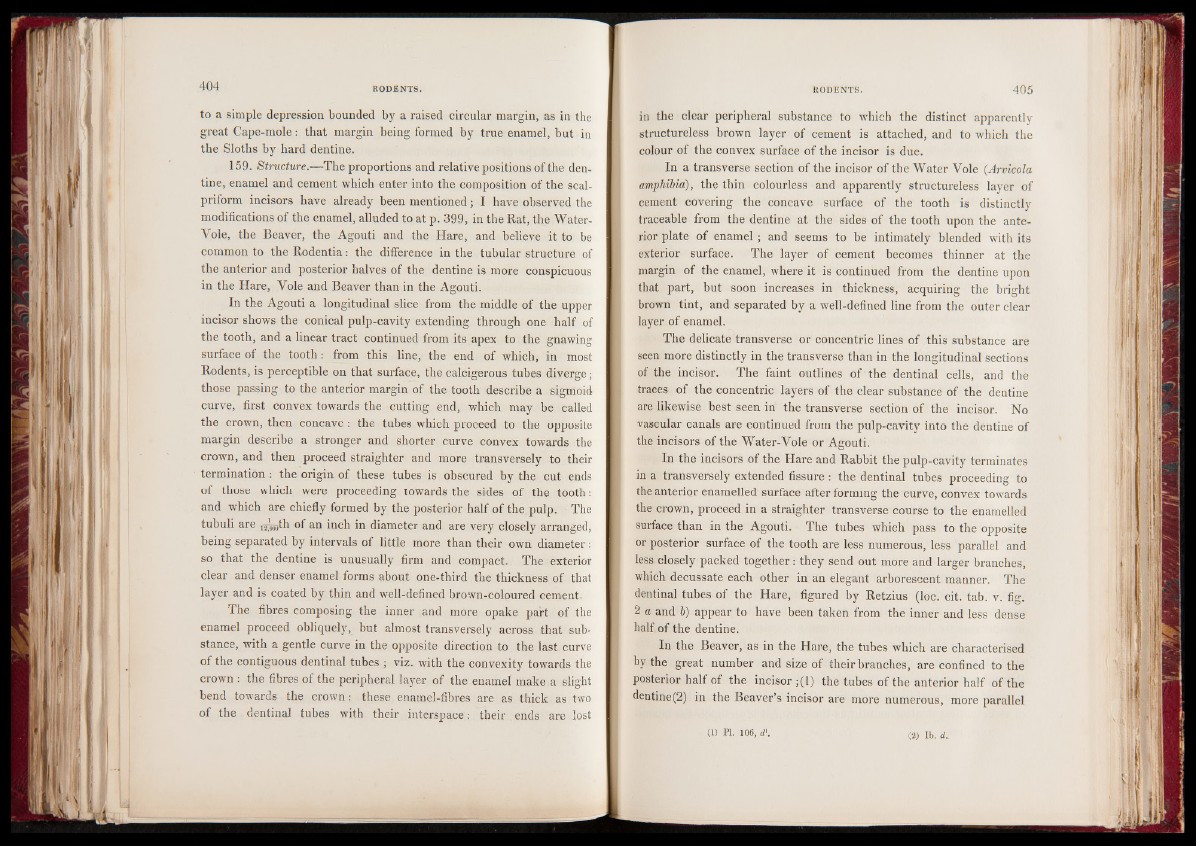
to a simple depression bounded by a raised circular margin, as in the
great Cape-mole $ that margin being formed by true enamel, but in
the Sloths by hard dentine.
159. Structure.—The proportions and relative positions of the dentine,
enamel and cement which enter into the composition of the scal-
priform incisors have already been mentioned; I have observed the
modifications of the enamel, alluded to at p. 399, in the Rat, the Water-
Vole, the Beaver, the Agouti and the Hare, and believe it to be
common to the Rodentia: the difference in the tubular structure of
the anterior and posterior halves of the dentine is more conspicuous
in the Hare, Vole and Beaver than in the Agouti.
In the Agouti a longitudinal slice from the middle of the upper
incisor shows the conical pulp-cavity extending through one half of
the tooth, and a linear tract continued from its apex to the gnawing
surface of the tooth: from this line, the end of which, in most
Rodents, is perceptible on that surface, the calcigerous tubes diverge ;
those passing to the anterior margin of the tooth describe a sigmoid
curve, first convex towards the cutting end, which may be called
the crown, then concave: the tubes which proceed to the opposite
margin describe a stronger and shorter curve convex towards the
crown, and then proceed straighter and more transversely to their
termination | the origin of these tubes is obscured by the cut ends
of those which were proceeding towards the sides of the tooth:
and which are chiefly formed by the posterior half of the pulp. The
tubuli are u^th of an inch in diameter and are very closely arranged,
being separated by intervals of little more than their own diameter :
so that the dentine is unusually firm and compact. The exterior
clear and denser enamel forms about one-third the thickness of that
layer and is coated by thin and well-defined brown-coloured cement-
The fibres composing the inner and more opake part of the
enamel proceed obliquely, but almost transversely across that substance,
with a gentle curve in the opposite direction to the last curve
of the contiguous dentinal tubes ; viz. with the convexity towards the
crown : the fibres of the peripheral layer of the enamel make a slight
bend towards the crown: these enamel-fibres are as thick as two
of the dentinal tubes with their interspace : their ends are lost
in the clear peripheral substance to which the distinct apparently
structureless brown layer of cement is attached, and to which the
colour of the convex surface of the incisor is due.
In a transverse section of the incisor of the Water Vole (Arvicola
amphibia), the thin colourless and apparently structureless layer of
cement covering the concave surface of the tooth is distinctly
traceable from the dentine at the sides of the tooth upon the anterior
plate of enamel; and seems to be intimately blended with its
exterior surface. The layer of cement becomes thinner at the
margin of the enamel, where it is continued from the dentine upon
that part, but soon increases in thickness, acquiring the bright
brown tint, and separated by a well-defined line from the outer clear
layer of enamel.
The delicate transverse or concentric lines of this substance are
seen more distinctly in the transverse than in the longitudinal sections
of the incisor. The faint outlines of 'the dentinal cells, and the
traces of the concentric layers of the clear substance of the dentine
are likewise best seen in the transverse section of the incisor. No
vascular canals are continued from the pulp-cavity into the dentine of
the incisors of the Water-Vole or Agouti.
In the incisors of the Hare and Rabbit the pulp-cavity terminates
in a transversely extended fissure : the dentinal tubes proceeding to
the anterior enamelled surface after forming the curve, convex towards
the crown, proceed in a straighter transverse course to the enamelled
surface than in the Agouti. The tubes which pass to the opposite
or posterior surface of the tooth are less numerous, less parallel and
less closely packed together: they send out more and larger branches,
which decussate each other in an elegant arborescent manner. The
dentinal tubes of the Hare, figured by Retzius (loc. cit. tab. v. fig.
2 a and b) appear to have been taken from the inner and less dense
half of the dentine.
In the Beaver, as in the Hare, the tubes which are characterised
by the great number and size of their branches, are confined to the
posterior half of the incisor ;(l) the tubes of the anterior half of the
dentine(2) in the Beaver’s incisor are more numerous, more parallel